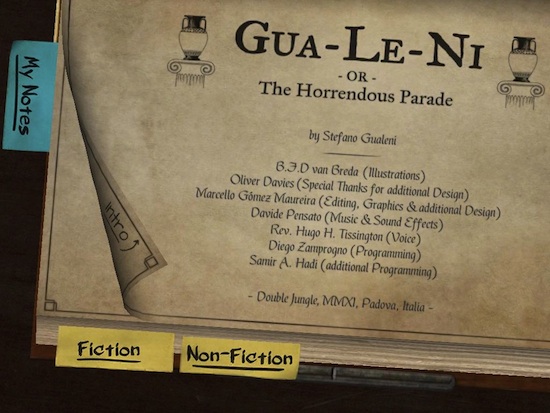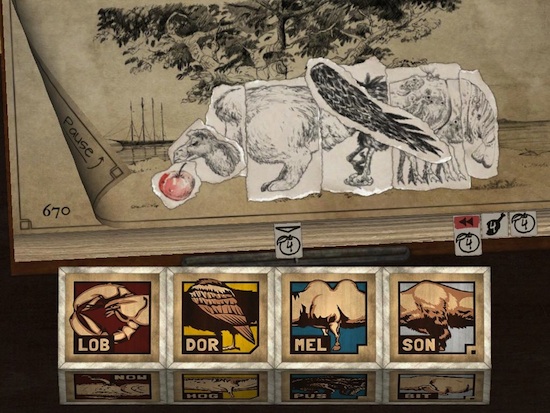Double Jungle’s upcoming “Gua-Le-Ni, or: The Horrendous Parade” is one of the more oddly titled games that ever to come into my mailbox. According to the developers, it’s the first commercially-released casual video game whose development and tuning were guided by the analysis of its players’ psychophysiological responses.
Padova/Breda, November 15, 2011. Double Jungle and Stefano Gualeni announce that their first iPad videogame “Gua-Le-Ni, or: The Horrendous Parade” is a few days away from release.The game, that was inspired both by the British philosopher, David Hume and by a playful Mexican book that allows recombination of animal parts, is the first commercially-released casual video game whose development and tuning were guided by the analysis of its players’ psychophysiological responses.
Starting from very early builds, The Academy for Digital Entertainment at NHTV Breda University of Applied Science (The Netherlands) assisted the Italian development team of Double Jungle in obtaining a detailed insight into the psychophysiological (or biometric) effects that their casual action puzzle video game had on its target audience.
In particular, the experiments correlated stress levels and the contraction of facial muscles with in-game performance in order to establish whether ‘Gua-Le-Ni’ offered the cognitive challenge, the learning curve, the duration and the enjoyment the designers had in mind for their product.
For example, the cognitive stress related to different speeds within the game and to the relative complexity of the beasts in play was tested on early prototypes. Such analysis, carried out on a large sample of users in the intended target audience of “Gua-Le-Ni” (casual gamers between 20 and 40 years of age, especially females), not only helped the BD4CG team to fine-tune the game, but often led to drastic changes in its game design and graphical looks.
In a test occurring later in the development of “Gua-Le-Ni”, the cognitive stress involved in going through the tutorial was also scrutinized. The focus was trying to understand whether it provided with enough interaction and entertainment, whether our testers felt empowered and in control after having gone through it. Cognitive stress, performance stress and flow are just some of the parameters that have a bodily expression that we decided to monitor throughout the quick iteration of our pioneering puzzle game.
Besides for its technical and methodological innovation, “Gua-Le-Ni” also offers formal innovations. To begin with, it gives traditional ‘matching’ mechanics a new twist. “Gua-Le-Ni” asks the player to recognize combinatorial beasts and to reconstruct them by actively manipulating digital objects in three dimensions. This new take on a classic game mechanic is made possible by the unique interactive capabilities of the Apple iPad.
The second mechanic which is unique to “Gua-Le-Ni” is a reverse-matching mechanics which translates into the feeding the in-game beasts with different food types. This mechanic depends on the availability of food in the playing field and on the specific food preferences of each beast. Feeding the beasts with different food combinations items can make them faster, slower, longer, shorter, more complex or more valuable in terms of points.


